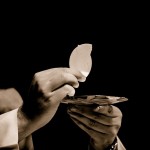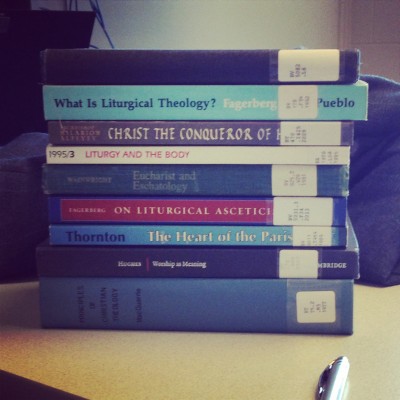Sermon Notes – Easter 3 – Year B – Breaking Open A Different Kind Of Bread
Thesis
The Collect appointed for the day would fit nicely with the story of Jesus breaking bread with disciples on the Road to Emmaus, but unfortunately that is not the scene with which we’ve been presented. Instead we have Jesus eating in front of his disciples and then breaking open the Scriptures for them. Remember Jesus’ words while in the wilderness: “man does not live by bread alone but by every word that comes from the mouth of God.” Perhaps we can begin seeing the Scriptures as a form of heavenly manna that sustain us; perhaps we can allow Jesus to break open the Scriptures for us that we might understand him and the Story even more; and perhaps when the Scriptures are opened and we are feasting on the word we will be more able to feast on the Word of God weekly through Eucharist.
Analysis
Collect
O God, whose blessed Son made himself known to his disciples in the breaking of bread: Open the eyes of our faith, that we may behold him in all his redeeming work; who lives and reigns with you, in the unity of the Holy Spirit, one God, now and for ever. Amen.
This Collect feels a bit out of place in Year B given the Gospel reading. It pairs up much better with the story of Jesus joining the two disciples on the Road to Emmaus when he is truly revealed in the breaking of bread. This reference has to be at the forefront of your mind as you write and preach, but you might want to avoid the desire to move from here to there. A reference here or there will be sufficient because to jump from one to the other would be to confuse the narrative. What really jumps out, then, from this Collect is that we need our eyes to be opened and we need to behold the Lord’s redeeming work. Preach on that. Let the Road to Emmaus come up next year, or the year after, and preach a beautiful sermon on the four-fold action of the Eucharist then.
First Lesson – Acts 3:12-19
I’ll be honest: this is a bizarre selection from the RCL. We are still moving in a non-linear fashion as we encounter Acts during Eastertide. Last week we were in chapter 4 and today we move back to chapter 3; both of these chapters take place after Pentecost and we are still 35 days away from that feast! What’s more, this lesson leaves out verses 1-11 and 20-26. It is not that this is a stand-alone pericope and the verses I’ve just mentioned are dispensable. Rather, the former provide the context and the latter provide further meaning and explanation from the lips of Peter. If you use this passage in your sermon you’ll have to help piece Humpty-Dumpty back together.
Verses 12-19 come on the heels of a healing miracle. Peter has healed a well-known lame man. This man was carried to the gate of the temple (the Beautiful Gate) so he could collect alms. Peter has no money to offer him. Instead he offers him healing in the name of Jesus Christ of Nazareth. People see the healed beggar “walking and praising God” and they want to know more. This is the context of Peter’s homily about the person of Jesus. Without verses 1-11 our pericope doesn’t make sense.
Peter explains who this Jesus of Nazareth is. The crowd is beginning to attribute healing power to Peter and John but Peter wants to correct this immediately. The power doesn’t belong to him, it belongs to Jesus. Peter connects the dots between the God of Abraham, Isaac and Jacob (recalling the mighty works of YHWH’s covenant faithfulness) and the Jesus whom they murdered (the Faithful Israelite). YHWH has glorified Jesus even though you killed him.
Peter holds nothing back in his message: “you killed the Author of Life and God raised him from the dead.” The Cross and Resurrection—again, see them as one—are the central event in Christianity; indeed they are the hinge upon which the history of the world turns. They killed Jesus but God had the last word: resurrection, new life, new creation…victory.
It is Jesus the Risen One who has made this man well. Not me. Not you. Jesus. I’m reminded of N. T. Wright’s strong urging in After You Believe when he states that we are to build for the kingdom. We cannot build the Kingdom just as a stonemason does not build the cathedral. The stonemason builds for the cathedral in whatever tiny way he or she is able; likewise, we don’t build the Kingdom—God does—we simply join God in his already active, always present work.
Peter’s last line (in this lesson) is scathing: “you acted in ignorance and so did your rulers.” But ignorance doesn’t get them off the hook. They still need to repent. They need to turn to God. And so do we. Faith in the Son of God means that we can no longer feign ignorance; it means that we are called to proclaim the works of God just as Peter did; it means that we are called to witness to what God has done in Christ.
Again and again in the book of Acts we see Peter (or others) encountering the powers, principalities or peoples of this world who are opposed to the Risen One and he does so with a proclamation that bears witness to who Jesus is and what he has done. Are we telling the story? Are we proclaiming truth? Are we witnessing to the works of the Almighty?
Psalm 4
This Psalm of praise and supplication is bookended with remarks about God’s sovereignty. It is particularly meaningful in the context of Easter 3 because it further demonstrates the call to place one’s trust in God. God is worthy of our trust. He has demonstrated time and time again that he is faithful, that he is active, and that he loves his creation.
Verse 2 strikes a discordant note with the rest of the Psalm. Here talk of idols and false worship sticks out like a sore thumb in the context of the living and active God of Israel. But isn’t that the point? How can one worship an idol when he has seen the lame healed, or the blind given sight, or the dead raised to life? How can idols compare to Almighty God? They cannot, but are we offering the world a picture of the triune God that is authentic and awful (in the truest, awe-inspiring sense) or are we giving the world a “Jesus-in-your-pocket” version of Christianity?
The Psalmist declares God to be “defender of my cause”; one who “does wonders”; one who “will hear me”; one who puts “gladness in my heart”; and one “who makes we dwell in safety.” That is a powerful picture compared to lifeless idols of wood, metal, money, or anything else that is not God.
Epistle – 1 John 3:1-7
We are children of God and are therefore somehow like God. Not perfectly and not completely this side of Glory, but we are still his children. Some day we will be more completely like him. Justification has happened—we have been made his children through adoption—but sanctification is ongoing and will only be completed through glorification. But let’s talk about sanctification.
As I mentioned last week, 1 John has been used to conjure up some interesting views of postbaptismal (or post-conversion) sin. Here we see John suggesting that no one who abides in him (Jesus) sins. This isn’t to suggest that we are sinless, for that is not possible, but to suggest that we are no longer slaves to sin and therefore we aren’t in sin they way we used to be.
We have to believe that in Christ we are new creations and the old has gone (1 Cor. 5:17). We have to believe that God has started a good work in us and will complete that work, but work is not yet completed. This is a prime example of the “already but not yet.” I have already been cleansed of my sins through the blood of Christ and the waters of baptism but I have not yet been sanctified and glorified to the point of being sinless and like Christ. Through the power of the Spirit I am to strive daily to be more like Christ but that is always an imperfect attempt. Rome wasn’t built in a day; it was built daily.
Please, please, please do not use this passage to suggest sinlessness. Take John at this word and understand that we are God’s children (and therefore co-inheritors) and that there is something started in us that will be completed later. We are to strive toward righteousness because Christ is righteous.
Gospel – Luke 24:36b-48
Here is where things get fun. The RCL cuts out the first half of verse 36 and therefore severs the tie between this passage and our Collect with the story along the road to Emmaus (don’t get me started on the RCL, it’s like Churchill’s famous description of democracy). Just to recap: Jesus is walking along to the road to Emmaus and meets up with two disciples. They do not recognize him and he asks them why they seem so gloomy. They go on to relate the events that have just (three days earlier) transpired in Jerusalem and about the death of Jesus. Jesus opens up the Scriptures to them and tells them all about what was prophesied and then was fulfilled. Finally he breaks bread with them by “taking, blessing, breaking and giving” and they recognize him as the Risen Lord.
Therefore, in Luke 24:36a the disciples who traveled with Jesus (unknowingly) along that road and then saw him revealed in the breaking of bread have now reached Jerusalem and are sharing the news with the disciples gathered. Without this piece of the puzzle we completely miss what is taking place. The disciples are heralds of the Risen Lord and are sharing this news with the rest. And then Jesus appears.
We know from the second half of verse 36 that others (companions) are gathered with the 11. Jesus appears and speaks, “Peace be with you.” This is not some quaint greeting, but rather it is the shalom of God speaking shalom over his people. Jesus is God’s peace and he gives it freely to his followers.
This recounting is contrasted with John’s account of Jesus’ appearing to the disciples because in John’s Gospel there is no need to see the hands and side until Thomas comes into the scene because he doubts. But here the disciples need to be calmed from fear and need to be shown that Jesus isn’t a ghost but is the Risen One. And yet it still isn’t enough. They have joy but they still have doubts and so Jesus asks for food to fully demonstrate that his risen body is real, is tangible, and yet is transformed.
After eating the bread he begins to open up the Scriptures to his followers. This is exactly like what he has just done for the two on the road to Emmaus. Jesus relates how he is the fulfillment of Moses (law), the prophets and the Psalms. Indeed he is the Faithful Israelite who has keep God’s covenant and is the Suffering Son of Man. The disciples can finally understand this reality in the fullest sense because they have experience and encountered the Resurrected One. Fr. John Behr of St. Vladimir’s has written an important book on this topic, Thy Mystery of Christ: Life in Death. Fr. Behr reminds the reader that we can only fully know Jesus as he is revealed after the resurrection.
Liturgical Considerations
There is nothing particularly special about Easter 3 in a liturgical sense, but I do think that this grouping of lessons provides a teachable moment for your parishes and congregations. Actually, isn’t that the point of Eastertide? We have a 50 day feast to celebrate with great joy that Jesus is risen. Then we will celebrate the Ascension and the Feast of Pentecost: i.e. the ministry of the Holy Spirit. During Eastertide we learn at the feet of Jesus while he appeared to over 500 people.
Most liturgies, regardless of form, can be divided (some more nicely than others) into a “Liturgy of the Word” and a “Liturgy of the Table.” Now, some churches make the mistake (yes, I’m preaching now) of trying to highlight one over the other. This is a mistake because a) they are intimately connected in Christ and b) because to highlight one is to make the other seemingly deficient.
I believe that a proper liturgy is one that is doubly climactic. The sermon and the Eucharist are both considered high points in the liturgy and one cannot be understood without the other. For the sermon is the explication of the lessons and is fleshed out and applied most fully with the Eucharist; to have a sermon without the Eucharist is to have a feast of the mind without feasting on the Body and Blood of the Lord (that which gives true spiritual nourishment. Likewise, the Eucharist needs to be “set-up” and “prepared” by the lessons and sermon because the Word of God is known through the revelation of God’s word. To have the Eucharist without lessons and a sermon is to rob the Eucharist of it’s interpretive meaning and matrix. So, highlight both parts of the liturgy as being equally meaningful and necessary. Jesus broke open the Scriptures for his followers after he gave himself up to be broken. Jesus broke bread with his disciples in the Upper Room and gave us a meal to celebrate often in his remembrance. Teach on this if you can and I think you’ll provide a nice teaching point for your parishes.
If you are not part of a church that celebrates Communion on a regular basis then perhaps you can consider moving in that direction and use this week’s lessons as the catalyst for that.
Synthesis
Pray that the Spirit would work through you and open up the minds of your listeners to understand the Scriptures.
Pray that many would heed the call to repent of their sins and amend their lives.
And pray that Jesus would be known throughout all generations to the ends of the earth.
The Collect reminds us that Jesus has been revealed in the breaking of bread. Jesus also reveals himself by breaking open the Scriptures (and our minds) that we might understand. The intersection of the Collect and lessons this week can be found here: we can encounter the Risen Lord in the bread and wine because he has been revealed in the Scriptures. We cannot, nor should we, separate word from table.
I want your “so what” to become a “now what?” The disciples encountered the resurrected Jesus, they received his peace, they touched his hands and side, they watched him eat, and then they learned from him. Now what? Well, Peter and John go forth and begin healing in Jesus’ name and proclaiming Jesus to all whom they meet. That’s a good application point!
Finally, may we cling to the Risen Lord and learn at his feet for the 50 days of Eastertide before we move into Ordinary Time and the ministry of the Holy Spirit. How can we fast when the bridegroom is with us? May we feast on his words and the divine Word!











